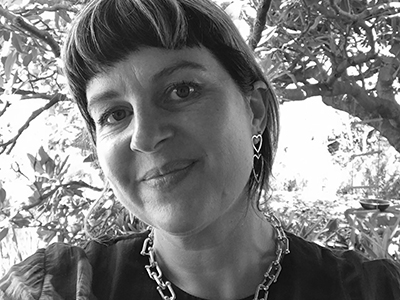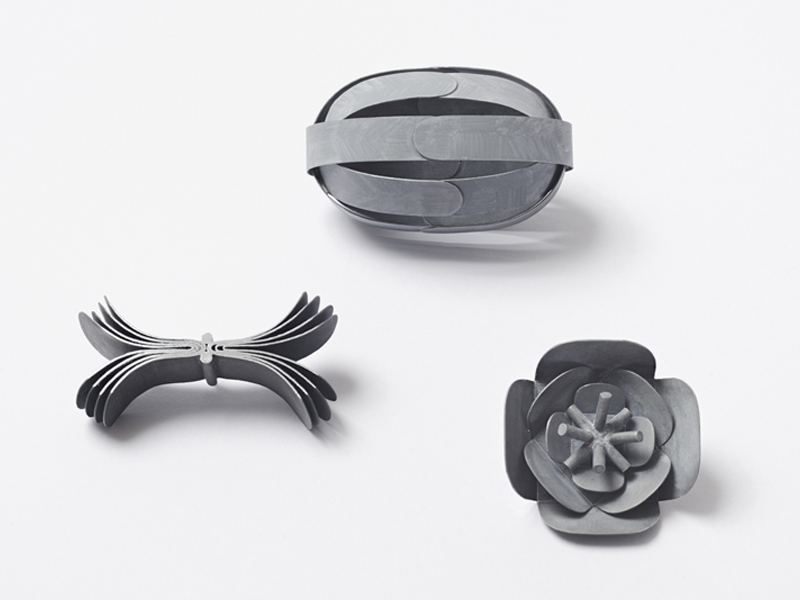
Dutch artist Lucy Sarneel is very busy: While simultaneously attending to various teaching duties and producing work for the galleries that represent her—like Gallery O, in Seoul—she is also currently working toward a major solo exhibition at CODA Museum in Apeldoorn, the Netherlands. Our last AJF interview with Lucy focused on her Soulmates exhibition, providing an overview of her background, teaching methods, and some of the material and thematic concerns running through her jewelry practice. This interview focuses on how Lucy’s work has evolved over the last three years, her current interests, and the upcoming CODA exhibition.
Meredith Turnbull: You are currently working on the project Private Territory in Public for CODA. Can you tell us a little about what you are presenting for this exhibition?
Lucy Sarneel: The exhibition Private Territory in Public is a mid-career overview of my work. The interaction between the private and the public, for the maker as well as for the viewer and wearer, is the guideline through this exhibition. In the first instance, my private thoughts, feelings, and experiences drive me to make. It’s a process from me to the other. A jewel, with its small ambit, finds itself, stored away or not, always in the big world. Leaving the safe haven of the drawer by wearing jewelry, and by showing it in public, on one hand ends but at the same time enhances the private. A jewel is an intimate object, dealt with in a specific manner; you could say that jewelry marks out someone’s personal territory. It defines the wearer and affects how the wearer is perceived by people they encounter. There are so many layers in this private-public tension that have always intrigued me. There’s something mysterious about jewels for me because they lead a kind of secret existence.
The CODA Museum started collecting my work at the beginning of the 90s, and most of the pieces they collected will be shown in the exhibition, along with other related pieces of jewelry from this period in my work. But the majority of the work shown was made in this millennium.
I’m also planning the setup of the exhibition, which, for me, is an interesting and exciting thing to do. Working on the maquette made me remember the pleasure of building houses for my Barbies during my childhood. But this is serious now and I find it difficult to estimate how it will work in real size…

Your work consistently draws out thematic or narrative elements from cultural histories in the form of artifacts, religious or cultural symbols like offerings, or traditional decoration or dress. You describe this eloquently as “the field of tension between the inspiring past and the untouchable present.” This is evident in your use of zinc in reference to Dutch architecture or in the materials and forms of the Daily Offer series. How or why is this field of tension an ongoing inspiration in your work? What objects or sites of tension are you currently reflecting on or working with?
Lucy Sarneel: Maybe I can explain by giving an example. When I was a little child, my mother revealed an old triangular leather sewing box to me. It was full of strange utensils, little treasures made out of ivory, silver, wood, lacquer, etc. And she also showed me other objects from her parents’ house, like a silver pencil-pen, little dice of blue glass in a hollowed-out cork, long ivory pins in a wooden container, boxes of leather or horn enclosing little photographs, a metal globe with a hole which functioned as a pencil sharpener … I was fascinated by the mysterious atmosphere of these beautiful, functional objects. They seemed familiar to me because they told about “our” history, but they were also very strange; rarities from an unknown, bygone world. These objects lived a life, and through time they turned into artifacts, witnesses of a certain person, place, and time in history. This combined experience of familiarity and alienation intrigues me enormously. I want to draw a line between the past and the present. The past runs through the present and the present becomes the past in a flash of time.
Recently I participated in a project called The Spakenburgse Diva‘s. The Spakenburgse Diva’s are three women (Corrie, Hendrikje, and Wijmpje) from the village of Bunschoten-Spakenburg, a small village on the Zuiderzee near Amersfoort in the Netherlands. Artists Hans Lemmerman and Inge van Run (who work together under the name Het Wilde Oog) have worked with them for 16 years, filming, photographing, and performing with them. For this project they invited eight artists to work on two so-called “kraplappen,” related to the artist Joseph Beuys. A “kraplap” is the most characteristic component of the Spakenburg costume, a starched strip of textile ± 45–50 cm wide and 70–80 cm long.
The Spakenburgse Diva’s belong to the last generation of women still wearing their complete costume. One could regard them as shamans, expressing the practices of their ancestors, a dying, almost vanished “tribe.” In this respect I see a connection with Beuys’s “shamanistic costume,” the fishing jacket that he always wore. He is quoted as saying “Ich kenne kein Wochenende” (I have no weekends) about it. One kraplap I chose for this purpose is made of an Eastern, ornamented textile. My respect for the costume tradition of Spakenburg made me intervene as minimally as possible, by means of barely visible incisions. My intention was to create an abstraction of the fishing jacket idea in a bent, seemingly starched (by filling it up with plastic sheet) “language.” The zinc elements serve as attachments for the textile elements as well as autonomous shapes (inspired by functional parts of the fishing jacket). A wearable synergetic collection of objects, typical for Joseph Beuys’s visual art.
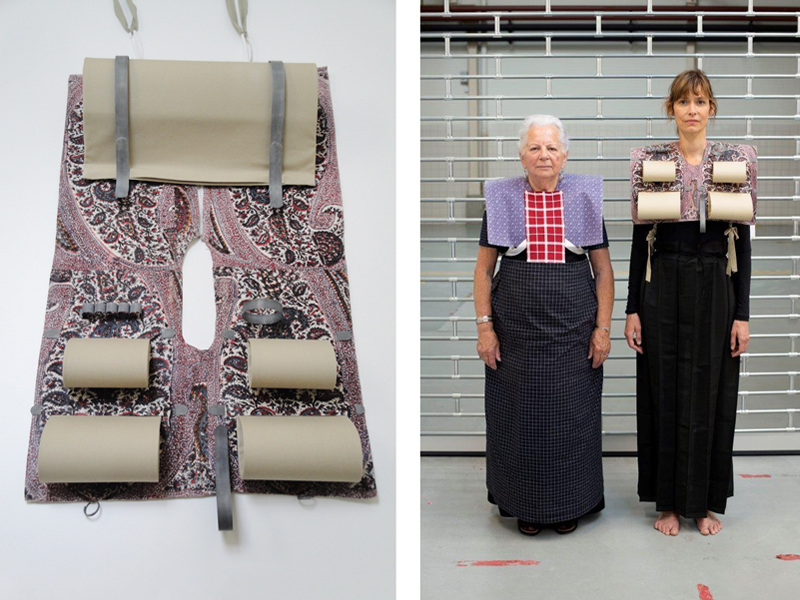
For the other kraplap, the starting point was a combination of aspects of Joseph Beuys’s life and work. Before his life as an artist, he was radio technician in a Stuka bomber. The isosceles blood-red cross appears in his visual art as both traditional Christian signs and as a hallmark of when a work of art “functioned well” according to his standards. It made me think of the visor of a rifle and when I did some research on World War II Stukas, this airplane proved to carry such crosses on its wings. Beuys was intrigued by the flow of energy—energy in both the material and mental meaning of the word—to him they were co-equal and mutually interwoven. Another aspect involved in the working process was Beuys’s statement that art was interesting to him to the extent of its potential for dialogue with people. For Beuys, art was a kind of therapy in order to bring people closer in contact with each other and to enhance society. This brought me to the essential potential of jewelry as a communicative medium. The crosses, zooming in and out in dimension (as perceived from an airplane), camouflaged with the similar textile of the kraplap, became brooches which can be given out to every person who feels a generous responsibility for someone else. A kraplap is an impressive “colossus,” a seemingly independent object on the body—in this case an imaginary airplane. Airplane wings on both sides of the wearer’s head—the pilot of a vehicle of culture in a landscape of distinction.

Another recent work is a series of medallions, pendants and photo frames in one. You can scroll a picture in, secretly kept for yourself. Jewelry, when not worn, is often put away, out of sight. For me jewelry belongs to everyday objects. Just like for instance a souvenir, a photograph, a piece of tableware, or any other object that has a specific story, a jewel reminds you of a certain person, place, or occasion in life.

I’m also interested in your ability to pare back a form to its essential elements and to convey these as pure structure, such as the Medallion or aspects of the Daily Offer series. How do you go about translating a form you might have observed from history or the everyday into a structural form within jewelry?
Lucy Sarneel: I guess it’s a matter of enjoying observing things, experiencing them in an animated way. I’m interested in the shape, materiality, construction, color, atmosphere, cultural background, etc. of things, regardless of the function. At the same time, they represent a symbol or they act as attributes in imaginary rituals, following from their function or use (a mirror, a cup, a sieve, a ball…). I find the “thingness” of jewelry interesting; we own things as much as they own us. Words such as “tool,” “souvenir,” “showpiece,” but also “waste,” “remnant,” or “reserve,” indicate the social life of things. The way people deal with things, their relationship with them, gives them meaning. In their homes, people tend to surround themselves with things that are dear to them, which they display in places they have specially selected for them. Intimate pieces of their lives on show, toward which feelings can be directed. As I said, jewelry, when not worn, is often put away, out of sight, but I think it’s natural to give it a place among everyday objects, and if you feel like it you can wear it.
It is with these thoughts in mind that the Medallions came about.
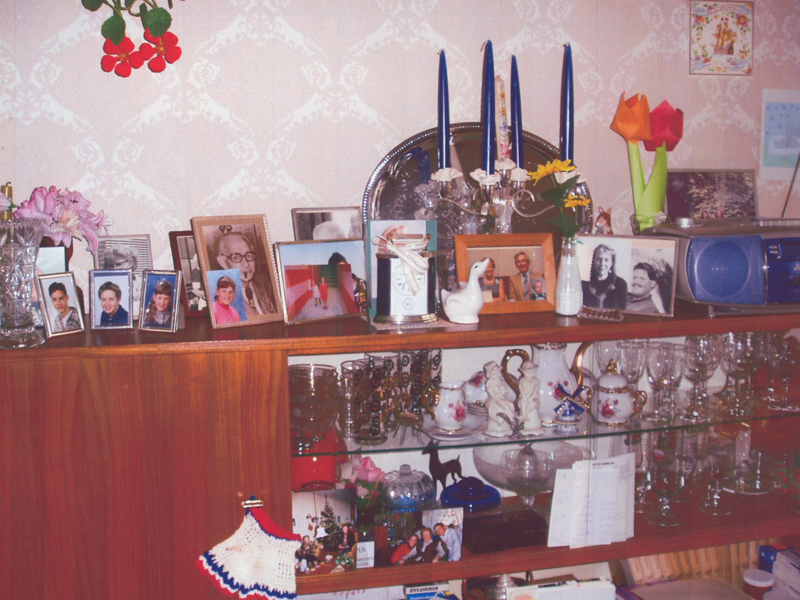

Because of this structural quality and your approach to scale, your work often conveys a strong sculptural dimension. You’ve talked about Joseph Beuys’s work in relation to your work for The Spakenburgse Diva’s, but how does an observation of sculpture intersect more broadly with your work? Do you think about sculpture when researching or making a work?
Lucy Sarneel: I don’t think about sculpture in particular when I make a work, but I’m challenged by “getting the most of the space,” within the limitation that meets the conditions of jewelry. A sculpture is an independent object and consequently not to be confused with a jewel; a jewel may possess sculptural qualities. My work is often a holistic collection of objects, yielding a three-dimensional piece of jewelry. We carry all sorts of practical things we need every day; jewelry provides the spiritual in daily life.
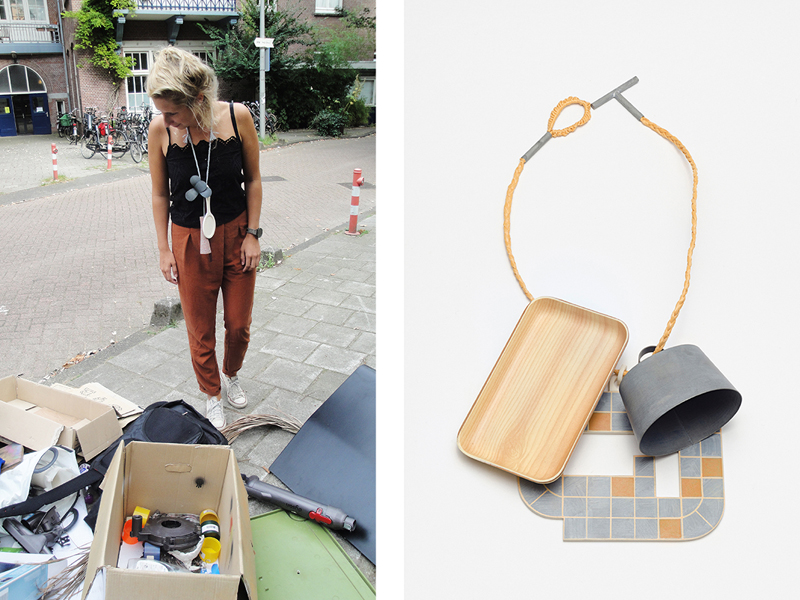
The Daily Offer series was begun in 2012. The title is borrowed from Bali, where daily offers made of folded leaves, flowers, money, and food—from rice to whole roasted chickens—are made with skill and dedication, thanking the gods for each new day. In this series, indigenous visual vocabulary reminds us of how the commercial world exploits a vanishing society, making it part of a socioeconomic industry of would-be authenticity. Its people then cultivate their own culture in order to satisfy the image that the West has formed of them.
In the West, a “daily offer” is a changing daily advertising stunt to tempt people into buying something. The title also refers to the daily human sacrifices to our complex world. In composed bundles, this series brings together the sacred and the profane, the natural and the artificial.
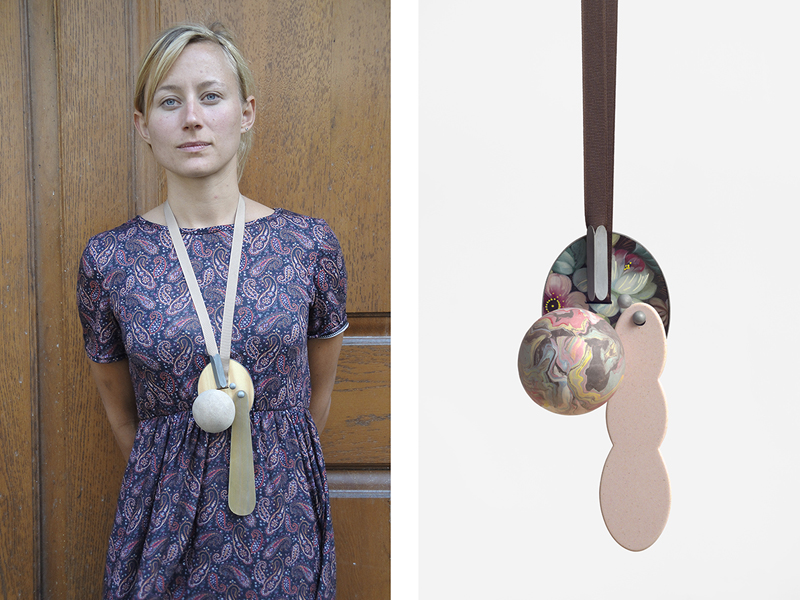
The Juggler’s Moment series was begun in 2013. Like jugglers, we are perpetually trying to keep all the balls in the air, following role patterns and tasks that we must or want to fulfill. Finding the right balance between the powers that drive us individually and those of the world around us is an art. The Juggler’s Moments are compositions of more or less the same elements, each with its own character and material quality. When it comes to a standstill, the juggler’s ball brings everything into physical balance, but it somehow looks out of proportion.
Sometimes it’s unavoidable that a discussion about jewelry will incorporate how we can interpret its qualities when static, like the study of a piece of jewelry in repose, when photographed or on display in exhibition. Liesbeth de Besten describes this quality in your work in her chapter Reading Jewellery, in On Jewellery, as appearing “like a still life rather than a story.” This quality of jewelry is distinctly different from its performative dimension when worn on the body. I like to think of the body as a field that is activated and charged in a unique way when jewelry is worn on its surfaces. How does a piece of jewelry such as a necklace from the Juggler’s Moment series change for you when it is worn? How is the body, in turn, transformed by your jewelry?
Lucy Sarneel: To me, a piece of jewelry is an object of high concentration and energy, something that both the wearer and the viewer “zooms in on,” inviting both reflection and projection. In a much wider sense than traditional amulets, I see jewelry as a giver of strength, a protector, a counterweight to the complex world around us. A “soulmate,” radiating a person’s inner and reverberating outside world. A piece of jewelry is meant to be worn, to move along with the body, to “melt” together with someone’s personality and appearance. The transition from autonomous object to jewel is an intriguing phenomenon. Somehow the roles are reversed because on one hand the object loses autonomy and at the same time the wearer gains autonomy by wearing the object as a jewel. You could say that the body is spiritualized by wearing an outspoken piece such as, for instance, a Juggler’s Moment. And the wearer completes the jewel.
Both the Juggler’s Moment and the Daily Offer series articulate other issues you also often talk about in respect to your practice. For example the notion of balance works as a compositional element evident in the physical form of the work but also as an idea like work/life or material/spiritual balance. Can you tell us a little bit more about the function of “balance” in your practice?
Lucy Sarneel: I am looking for fields of tension, both in form and material as a metaphor for life in the quest for a balance of the forces we are influenced by. Everything is constantly balancing in seeking movement within us and around us, finding short moments of stability. This seeking for balance is what matters in my work—trying to get the essence by questioning what is important to communicate and what I want to “give” to my surrounding. There’s both playfulness and seriousness in balancing, which I find challenging to handle.
Finally, Lucy, can you tell us a little about what you like to do when you are not making? And what you have planned for yourself after this major project?
Lucy Sarneel: I like to read books, travel, dream away in our country house in France, talk to students about their ideas and work, visit exhibitions, watch movies and documentaries, spend time with my family and friends, listen to music, and sometimes dance … so many interesting things in life! After this project, I’m planning to work in my studio as always in struggle and pleasure. There are still a few Juggler’s Moments waiting to be made, and also some Daily Offers.
At the end of 2017 I will participate in an alternative initiative by Morgane de Klerk titled Stralen & Reflecteren. The project gathers the works of 12 artists based and/or educated in Amsterdam. The theme Stralen & Reflecteren—literally meaning “to shine & to reflect”—refers to the relationship that jewelry maintains with light and conceptual ideas. Jewelry is often represented as a bright and glossy object; it can be seen as magical, spiritual, precious, or superfluous. This exhibition aims to expand the spectrum of what ornament is and can be, as well as to bring conceptual jewelry to a broader audience in Paris. (It will be part of Parcours Bijoux 2017, Atelier Néérlandais.)
And while working and reflecting, new ideas present themselves. The urge to make always drives me.

INDEX IMAGE: Lucy Sarneel, Grey Medallions, 2016, pendants/photo frames, zinc, fishing line, dimensions variable, photo: Jan van Esch
***
インタビュー
2017年1月5日
ルーシー・サーネールに訊く
ギャラリーO、ソウル、韓国
メレディス・ターンバル
オランダ人アーティスト、ルーシー・サーネールは多忙なアーティストだ。複数の教職を持つかたわら、ソウルにあるギャラリー O をはじめとする、所属ギャラリーのための作品づくりに精を出し、オランダ、アぺルドールンの CODA 美術館で行われる大規模な個展も控えている。Art Jewelry Forumが以前に行った、「ソウルメイト」展について主に訊いたインタビューでは、経歴、教育方針、これまでのジュエリー制作に一貫する一部の素材やテーマについて語ってもらった。今回のインタビューでは、過去3年間でいかにして作品が発展したか、現在の関心、CODA で行われる個展を中心に話を聞いた。
メレディス・ターンバル:あなたは現在、CODA で行われる「プライベート・テリトリー・イン・パブリック」展の準備中だそうですね。この展覧会で何を展示するのか、少しお話しいただけますか?
ルーシー・サーネール:「プライベート・テリトリー・イン・パブリック」展は、キャリアの中盤にいる私が、これまでの仕事を振り返る展覧会です。作り手のみならず、鑑賞者や装着者にとっても、公私の相互作用がこの展覧会を見るうえでの指針となるでしょう。まず、私的な考えや感情、体験が私を制作に駆り立てます。私から他者へと向かう過程です。ジュエリーというのは、領域の小さな物ですから、しまってあろうとなかろうと、常に大きな世界にその身を託すことになります。ジュエリーを身につけることで、引き出しの中という安全な場所からジュエリーを連れ出し、さらに公の場にさらすことで、私的な側面が終わりを遂げると同時に増幅もされます。ジュエリーは、特定の作法で扱われる親密な物体です。ジュエリーは、個人の領域を規定するものだともいえるかもしれません。ジュエリーは装着者を定義し、その装着者が、出会う人からどう思われるかに影響を及ぼします。私を常々ひきつけてやまない公と私との張力にはきわめて多層的です。私にとって、ジュエリーは謎を秘めた存在です。なぜなら、ジュエリーはある種の秘密めいた生活を送っているからです。
90年代のはじめから私の作品がCODA 美術館に蒐集されるようになりました。そのほとんどが、私が同時期に制作した、その他の関連ジュエリー作品とともに次回の個展で展示される予定です。が、展示作品の大部分は2000年代に入ってから制作したものです。
展覧会の設営についても計画中で、この作業はおもしろく、わくわくします。模型を使った作業は、子どものころにバービー人形の家を作って遊んだときの楽しい気持ちを思い出させます。が、いまとなっては大まじめにそれをやっているわけで、実寸大にしたらどうなるかを推測するのに苦労しています…
あなたは常々、人工物や、供物などの宗教的・文化的象徴、伝統的な装飾や衣装といった形で、文化史から主題的・物語的な側面を抽出して作品をつくっていらっしゃいます。あなたはこれを「想像力をかきたてる過去と、不可避の現在のあいだに働く張力の場」であると雄弁に描写されています。これは、亜鉛の使用によってオランダ建築に言及している点や、「日々の供物」シリーズの素材や形態からも明らかです。この、張力の場はどういうふうに、またなぜ作品づくりのインスピレーションであり続けているのでしょう? 現在、考察や作業の対象としている、張力が作用する物体や場は何でしょうか?
ルーシー・サーネール:この点については、例を使って説明できるのではないかと思います。子どものころ、母が、三角形をした革製の古い裁縫箱を見せてくれたことがありました。その中は、風がわりな道具や、象牙や銀、木、ラッカーなどでできた小さな宝物でいっぱいでした。母は、ほかにも彼女の両親の家に置いてあった、銀色の色鉛筆や、くりぬいたコルクに収めた青ガラス製のサイコロ、木の入れ物にしまった象牙の細長いピン、革や動物の角でできた箱に入れた小さな写真、穴のあいた球型をしたえんぴつ削りといった品々も見せてくれました…私は機能をもつこれらの美しい物体の不思議な雰囲気にすっかり魅了されました。これらの品々は「私たちの」歴史を物語るがゆえ、身近に感じられたのと同時に、とても奇異にも感じられました。過ぎ去った未知の世界から来た謎のものという感じがして。これらの物体はその生涯を全うし、時間の経過とともに、遺物であり、特定の人物や場所、時間の目撃者へと変貌を遂げた存在です。こういった親和性と違和感との融合の体験は私を引きつけてやみません。私は過去といまとのあいだに境界線を引きたいのです。過去はいまのなかに生きていて、いまは一瞬で過去になります。
最近、「ザ・スパーケンブルグ・ディーバス」というプロジェクトに参加する機会がありました。スパーケンブルグ・ディーバスは、オランダのアメルスフォールトにほど近いゾイデル海沿いにある小さな村、ブンスホーテン‐スパーケンブルグ出身の女性3人組(コーリー、ヘンドライキア、ウィジピー)です。アーティストであるハンス・レマーマンとインゲ・ファン・ラン(2人はヘット・ウィルデ・オーグの名で一緒に仕事をしています)は16年にわたり、その3人と一緒に映画や写真の撮影やパフォーマンスを行ってきたそうなのですが、このプロジェクトでは、彼らが8名のアーティストに声をかけ、アーティストのヨーゼフ・ボイスに関連づけた、いわゆる「クラップラッペン」を2点作らせました。「クラップラップ」はスパーケンブルグ地方の衣装でもっとも特徴のあるパーツで、幅45から50センチ、長さ70から80センチの、糊をきかせた布地のことです。
スパーケンブルグ・ディーバスは、民族衣装を完全な形で着る最後の世代の女性です。消えつつある消滅したにひとしい「種族」である先祖の習慣を表現するシャーマンであるという見方もできるかもしれません。私は、そういった点に、ボイスの「シャーマン的な出で立ち」、つまり彼がいつも着ていた釣り用のジャケットとの関連性があると考えています。彼はそれについて「Ich kenne kein Wochenende」(私に週末はない)と発言したと言われています。この目的のために私が選んだクラップラップのひとつは、東部の装飾が施されたテキスタイルでできたものです。スパーケンブルグの伝統衣装に敬意を払いたいという思いから、介入は最小限に抑え、見えるか見えないかの切れ込みを入れるにとどめました。私の意図は、折り曲げ(中にプラスチックの板を入れることで)糊がきいているように見せかけた「言語」の形で釣り用ジャケットの概念の抽象を創り出すことでした。亜鉛の要素はテキスタイルのパーツどうしの留め具の役割を果たすだけでなく、自律した造形物としても機能します(釣り用ジャケットの機能を持つパーツに着想を得ました)。ボイスの視覚芸術の典型である相乗作用する物体の集積を身に着けられるようにしたものです。
もうひとつのクラップラップは、ボイスの人生と仕事のいくつもの相の結びつきを出発点としました。彼は、アーティストとしての人生を送る前、シュトゥーカ爆撃機の無線技士をしていました。彼の視覚芸術に登場する赤十字は、伝統的なキリスト教の象徴、そして作品が彼の基準通りに「きちんと機能している」かを示す品質証明だったそうです。赤十字は私にライフルのスコープを思わせ、第二次大戦時のシュトゥーカ機について調べてみたところ、機体の両翼に赤十字がついていたことがわかりました。ボイスはエネルギーの流れ――物質的、精神的の両義において――に魅力を感じていました。彼にとって両者は同等で相互に入り混じるものでした。作業工程に含まれたもうひとつの面としては、芸術は、人との対話の可能性を秘めているからこそおもしろい、というボイスによる発言があります。ボイスにとって、芸術は人々の距離をちぢめ社会をよりよいものにするための、一種のセラピーでした。このことから、コミュニケーションの媒体という、ジュエリーの本質的な可能性に思い至りました。(航空機から見たときのように)ズームインとズームアウトでサイズが違う十字架を、クラップラップと似たテキスタイルでカモフラージュしてブローチにし、他者に惜しみない責任感を抱く1人ひとりに渡せるようになっています。クラップラップは一見すると、身体上の独立した物体で、存在感のある「巨像」です――この場合は想像上の航空機ですね。機体の両翼が頭の両側に来るようになっており、装着者が文化という乗り物の操縦士になって独特の光景を創り出します。
近年のもうひとつの作品は、メダイヨンとペンダント、フォトフレームを合体させた連作です。写真を挿入して人知れずとっておくこともできます。ジュエリーは、装着時以外はたいてい見えないところにしまわれているものです。私にとってジュエリーとは日用品の部類に属します。たとえば、具体的なストーリーをもつ土産物や写真、テーブルウェアやそれ以外のあらゆるものと同じように、ジュエリーもまた特定の人物や場所、出来事を思い出させます。
私は、「メダイヨン」や、「日々の供物」シリーズの複数の面でみられるように、形状を本質的な要素までそぎ落とし、その純粋な構造を伝えられるあなたの技量にも興味があります。どのようにして、歴史や日常のなかからみつけた形をジュエリーにおける構造的な形状に落とし込んでいらっしゃるのでしょうか?
ルーシー・サーネール:それは、事物をいきいきと観察し体験することを楽しめるかどうかの問題ではないでしょうか。私は、機能にかかわらず、その物がもつ形や素材性、構造、色味、雰囲気や文化的背景などに興味があります。それと同時に、物はその機能や用途にしたがって(鏡やコップ、ふるい、ボールなど)シンボルになったり、想像上の儀式を象徴したりする役割を果たすこともあります。私はジュエリーがもつ「物性」に興味をひかれます。私たちは、物を所有するのと同じぐらい物に所有されています。「道具」「土産物」「展示品」はもちろん、「廃品」や「残り」「蓄え」という言葉もまた、物の社会的生活を示しています。物の扱いかたや、物との関係性が物に意味を与えます。人は家にいると、だいじな物に囲まれて過ごします。そういう物に専用の場所を選んでやり飾るわけです。思いを込めることができる、人生における親密な品々を飾るのです。先ほどお話ししたとおり、ジュエリーは、装着時以外はたいてい見えないところにしまわれていますが、日用品のなかにジュエリーのための場所を与え、気分が乗れば身につけられるようにしておくというのは自然なことだと考えています。
こういう考えがあって、「メダイヨン」が生まれました。
その構造性とスケールに対するアプローチのしかたゆえ、あなたの作品からはしばしば強い彫刻的な性質が感じられます。先ほど、「スパーケンバーグ・ディーバス」の作品とヨーゼフ・ボイスの仕事とを関連づけてお話されていましたが、彫刻への考察はどのようにしてより広範なかたちで作品と交わるものですか? リサーチや作品づくりのさい、彫刻について考えますか?
ルーシー・サーネール:制作時に、彫刻について特に考えたりはしませんが、「空間を最大限に利用」し、ジュエリーの条件に見合う範囲内に収めるという課題を自分に課しています。彫刻は独立した物体であるがゆえにジュエリーと混同されることはありません。いっぽうで、ジュエリーは彫刻的な性質を持ちえます。私の作品では、物体が集合体になり、結果として三次元のジュエリー作品になることがよくあります。私たちは日々に必要なありとあらゆる実用品を持ち運びます。ジュエリーは日常の生活に精神性を付与してくれます。
「日々の供物」シリーズをつくりはじめたのは2012年です。タイトルはバリの習慣から借用しました。バリでは、新しい1日1日を神に感謝し、技術と献身をもってして、折った葉っぱや花、お金、食べもの――お米からホールのローストチキンまで――を使って日々の供物がつくられます。このシリーズでは、バリ土着の視覚表現が、いかにして商業界が消えゆく社会を搾取し、偽の本物らしさが横行する社会経済界の一部にそれを取り込んでいくのかを思い出させます。そうなると、消えゆく社会の人々は、西洋圏の人間がそこから作り上げたイメージを満足させるがために、自らの文化を洗練させるのです。
西洋世界の「日々の供物」は、人々を誘惑し物を買わせようとする、日々移り変わる宣伝行為です。このタイトルは複雑な世界にささげられる日常の人的犠牲についても言及しています。束を構成したこのシリーズでは聖なるものと俗なるもの、自然物と人工物とを寄せ集めています。
「ジャグラーズ・モーメント」の制作をはじめたのは2013年です。私たちもジャグラーと同じで、果たさねばならない、または果たしたい役割やタスクに従い、すべてのボールを宙にとどめておこうと絶え間なく努力を続けています。私たち1人ひとりを突き動かす力と、私たちを取り囲む世界の力とのあいだに適切なバランスを見出すことがアートです。「ジャグラーズ・モーメント」は、多少なりとも同じ要素どうしを構成したもので、1つひとつが独特の性格と素材性をもちます。静止状態だとジャグラーのボールがすべての物理的均衡をとりますが、どこか比率がおかしいような印象を与えます。
ジュエリー論においては、ときとして、静止状態にあるジュエリーの性質をどう解釈するか、という点の議論が不可避です。たとえば、休ませている状態だとか、写真に撮影されたとき、展示中の状態の研究などがそうです。リズベット・デン・べステン氏は、あなたの作品がもつこの性質を、その著書である「On Jewelry」の「Reading Jewelry(ジュエリーを読み解く)」と題された章において「物語というよりも、静物的」な立ち現われかたをしていると描写しています。ジュエリーがもつこのような性質は、身につけられたときの発話的な性質とは明白に異なります。私は身体のことを、ジュエリーを身につけると、活性化し満たされるひとつの場であるというふうに考えるのが好きです。あなたにとって、ジャグラーズ・モーメントシリーズのネックレスなどのジュエリーは、身につけるとどのように変容するものなのでしょうか? また、いっぽうの身体もあなたのジュエリーによって変容させられるのでしょうか?
ルーシー・サーネール:私にとってジュエリーは、高い集中とエネルギーの物体であり、装着者と観者の両者が「接近」し、内省と投影の両方を促す存在です。私は、ジュエリーを、伝統的な護符よりもはるかに広い意味で力と加護を付与し、私たちを取り囲む複雑な世界に抗す力であると考えます。その人の内面を外に放ち、外的世界を反射する「ソウルメイト(魂の伴侶)」です。ジュエリーは身につけるためのもの、身体といっしょに動くもの、だれかの個性や容貌と「融け」合うものです。自律した物体からジュエリーへの移行は興味深い現象です。不思議と役割が反転するのです。なぜならば、物体が自律性を失うと同時に、その物体をジュエリーとして身につけることで、こんどは装着者が自律性を獲得するためです。たとえば、ジャグラーズ・モーメントのような率直な作品を身につけることによって、身体が霊化されるというふうにも言えるでしょう。そうやって、装着者がジュエリーを完成させるのです。
「ジャグラーズ・モーメント」と「日々の供物」の両シリーズは、あなたがご自分の習慣についてよく話をされている別の点についても述べています。たとえば、作品の物理的形状において明らかな、構図的な要素としての作品の均衡という概念だけでなく、仕事と生活、また物質と精神性との均衡という概念がそうです。あなたの習慣における「均衡」がはたす機能についてもう少し詳しくお訊かせいただけますか?
ルーシー・サーネール:私は、人生において私たちが影響を受ける力の均衡の探求として、形態においても素材においても、張力の作用する場を探っています。万物は、私たちに内在し私たちを取り囲む動きを探し求め、束の間の安定を見つけながら、絶え間なく釣り合いを保っているのです。私の作品においてはこの均衡の探求という行為が重要です――何を伝えることが重要で私が周囲になにを「与え」たいかを問うことで本質に到達しようとしています。そこには遊び心と真剣さの両立がありますが、その扱いは難しいものです。
最後に、制作をしていないときは何をして過ごすのがお好きなのか少しお聞かせいただけますか? また、この一大プロジェクトの終了後には、どんな計画が控えていますか?
ルーシー・サーネール:私は、読書や旅行、フランスの邸宅でぼんやり過ごすこと、学生たちと彼らのアイデアや作品について話をすること、展覧会に足を運ぶこと、映画やドキュメンタリーの鑑賞、家族や友人たちと過ごすこと、音楽鑑賞、ときにダンスも好きです…人生にはおもしろいことがたくさん! このプロジェクトが終わったらいつも通り苦しみと喜びに向き合いながら制作活動に戻るつもりです。ジャグラーズ・モーメントの作品を2,3点と、日々の供物もあとまだ何点か作らなければならないし。
2017年の終わりには、モーガン・デ・クラークによる「シュトラーレン&レフレクテレン」という活動に参加する予定です。このプロジェクトでは、アムステルダムで教育を受けたか同地を拠点に活動するアーティスト12名の作品を集めたものです。テーマである、「シュトラーレン&レフレクテレン」の文字通りの意味は「輝くことと反射すること」で、ジュエリーが持つ、光とコンセプチャルな概念との関係について言及しています。ジュエリーはピカピカと光る物体として表現されることが多く、不思議で霊的な物や、貴重品、余剰物としてみなされうるものです。この展覧会では、装飾品の何たるかと何たりえるかの範囲を広げること、そして、パリのより広範な人々にコンセプチャルなジュエリーを紹介することを目的としています(パルクール・ビジュー 2017、アトリエ・ニーランダイスの一貫で行われます)。
そして、制作や内省をしていると、新しいアイデアが姿を現します。作りたいという衝動がいつも私を突き動かすのです。
メレディス・ターンバル:メルボルンを拠点に活動するアーティスト、キュレーター、ライター。モナシュ大学のアート・デザイン・建築科にて博士号、ロイヤルメルボルン工科大学にて学士号(美術)、ラ・トローブ大学の美術史の優等学士号を取得。撮影:ロス・コルター
Translated from English by Makiko Akiyama.
